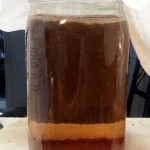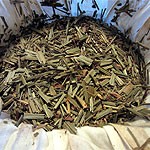How to Make Kombucha Easily
 Kombucha is a fermented drink that includes beneficial bacteria and yeasts for your digestive health! (Yep, I’m still working on my gut flora – LOL). The gut is ground zero for autoimmune disorders and is the seat of our immune system. How well we digest our food, how much of the nutrients from our food […]Read More »
Kombucha is a fermented drink that includes beneficial bacteria and yeasts for your digestive health! (Yep, I’m still working on my gut flora – LOL). The gut is ground zero for autoimmune disorders and is the seat of our immune system. How well we digest our food, how much of the nutrients from our food […]Read More »How to Make Your Own Herbal Ear Oil
 Ear infections are rather cantankerous buggers and can certainly cause a lot of pain. Something many people don’t realize is that up to 70% of all ear infections are actually viral. Antibiotics do nothing for a viral infection – they only benefit us when it is a bacterial infection. In May of 2003, Pediatrics published […]Read More »
Ear infections are rather cantankerous buggers and can certainly cause a lot of pain. Something many people don’t realize is that up to 70% of all ear infections are actually viral. Antibiotics do nothing for a viral infection – they only benefit us when it is a bacterial infection. In May of 2003, Pediatrics published […]Read More »How to Make Your Own Carpet Freshening Powder
 I found this simple yet wonderful little recipe for making your own carpet freshening powder. I realize this may not seem like a health related item, but those practicing aromatherapy may find it quite useful! Plus, I really do not like the fake aroma’s that are in the various carpet fresheners (air fresheners, aromatic candles, […]Read More »
I found this simple yet wonderful little recipe for making your own carpet freshening powder. I realize this may not seem like a health related item, but those practicing aromatherapy may find it quite useful! Plus, I really do not like the fake aroma’s that are in the various carpet fresheners (air fresheners, aromatic candles, […]Read More »How to Make Herbal Steam Inhalants and Herbal Lozenges
 Herbal steam inhalants are fairly simple to make. You just need a large bowl, a towel, a dried herb and boiling water. Get your water boiling. Place 1-2 tablespoons of dried herb in your large bowl and gently pour in the boiling water. You will want approximately 2-3 cups of boiling water per tablespoon of […]Read More »
Herbal steam inhalants are fairly simple to make. You just need a large bowl, a towel, a dried herb and boiling water. Get your water boiling. Place 1-2 tablespoons of dried herb in your large bowl and gently pour in the boiling water. You will want approximately 2-3 cups of boiling water per tablespoon of […]Read More »How to Make Herbal Compresses and Poultices
 Herbal compresses and poultices are applied topically. They are commonly used for muscle aches and pains as well as inflammatory conditions whether muscular or on the skin (such as eczema or psoriasis). They are also used for bronchial congestion and many other things as well. Herbal Compress’s are just a cloth pad that has been […]Read More »
Herbal compresses and poultices are applied topically. They are commonly used for muscle aches and pains as well as inflammatory conditions whether muscular or on the skin (such as eczema or psoriasis). They are also used for bronchial congestion and many other things as well. Herbal Compress’s are just a cloth pad that has been […]Read More »How to Make Herbal Aromatherapy Dilutions
 Aromatherapy is a term used to describe a wide range of therapies using aromatic oils, many in massage, for the aromas to be inhaled by the patient. Most aromatherapy applications are 2% dilutions. This means that 2% of the oil is made from essential oil or flower essences. So, for every 100 drops of carrier […]Read More »
Aromatherapy is a term used to describe a wide range of therapies using aromatic oils, many in massage, for the aromas to be inhaled by the patient. Most aromatherapy applications are 2% dilutions. This means that 2% of the oil is made from essential oil or flower essences. So, for every 100 drops of carrier […]Read More »How to Make Herbal Salves
 Also known as “balm” or “ointment”, salves are not as easily absorbed by the skin and form a separate layer on top of the skin. Unlike the Creams and Lotions, there are typically only oils or fats in a salve, no water. There are several methods and recipes for making salves. Play around with them […]Read More »
Also known as “balm” or “ointment”, salves are not as easily absorbed by the skin and form a separate layer on top of the skin. Unlike the Creams and Lotions, there are typically only oils or fats in a salve, no water. There are several methods and recipes for making salves. Play around with them […]Read More »How to Make an Herbal Essence and Essential Oil
 There are several ways to capture the oil of a flower for your own essences. One way is to evaporate it from flower petals in a tightly closed glass container. This is done on a windowsill or in the sun for several days. A pint of flower petals (you usually want very aromatic ones) will […]Read More »
There are several ways to capture the oil of a flower for your own essences. One way is to evaporate it from flower petals in a tightly closed glass container. This is done on a windowsill or in the sun for several days. A pint of flower petals (you usually want very aromatic ones) will […]Read More »How to Make Herbal Creams
 Creams or lotions are made from fats or oil mixed with water and they tend to soften the skin and are easily absorbed. There are several methods for making creams or lotions and many different recipes. We have listed two methods here to get you started. Play around, see what methods and recipes you like […]Read More »
Creams or lotions are made from fats or oil mixed with water and they tend to soften the skin and are easily absorbed. There are several methods for making creams or lotions and many different recipes. We have listed two methods here to get you started. Play around, see what methods and recipes you like […]Read More »How to Make Herbal Infused Oils
 Herbal oils are commonly used for massage, skin creams, salves, sunbathing oils, etc… They are for external use and generally keep up to 1 year in a cool dark place. Whether you choose the hot or cold infusion method mainly depends on the herb you are infusing. Cold Infusion Cold infusions are good for herbs […]Read More »
Herbal oils are commonly used for massage, skin creams, salves, sunbathing oils, etc… They are for external use and generally keep up to 1 year in a cool dark place. Whether you choose the hot or cold infusion method mainly depends on the herb you are infusing. Cold Infusion Cold infusions are good for herbs […]Read More »How to Make an Herbal Syrup
 Syrups are commonly used for children and are especially known for being soothing to the throat. They are basically infusions or decoctions that are preserved with honey or unrefined sugar. Start by heating your infusion or decoction in a saucepan (unless of course it’s already hot). Then add your honey or unrefined sugar, stirring constantly […]Read More »
Syrups are commonly used for children and are especially known for being soothing to the throat. They are basically infusions or decoctions that are preserved with honey or unrefined sugar. Start by heating your infusion or decoction in a saucepan (unless of course it’s already hot). Then add your honey or unrefined sugar, stirring constantly […]Read More »How to Make an Herbal Tincture
 Tinctures are made when you want something that is preserved and will keep for up to 3 years in your cupboard.This is a great option for herbs or remedies that you want to use for a few months. They do take a bit longer to make than infusions or decoctions though, and they contain alcohol. […]Read More »
Tinctures are made when you want something that is preserved and will keep for up to 3 years in your cupboard.This is a great option for herbs or remedies that you want to use for a few months. They do take a bit longer to make than infusions or decoctions though, and they contain alcohol. […]Read More »How to Make an Herbal Decoction
 Decoctions are generally used for twigs, bark, roots and some berries. Making a decoction is similar to making a tea, but slightly more vigorous than an infusion as bark, roots, twigs and some berries are not as ready to give us their active constituents. Place your herbs into a covered pan of cold water and […]Read More »
Decoctions are generally used for twigs, bark, roots and some berries. Making a decoction is similar to making a tea, but slightly more vigorous than an infusion as bark, roots, twigs and some berries are not as ready to give us their active constituents. Place your herbs into a covered pan of cold water and […]Read More »How to Make an Herbal Infusion
 Infusions are generally used for leaves and flowers and are basically the same as making a tea. Place your herbs into a pot with a close-fitting lid (like a tea pot). Boil your water in a separate container, taking it off the heat once it boils. Wait for a moment or two and the pour […]Read More »
Infusions are generally used for leaves and flowers and are basically the same as making a tea. Place your herbs into a pot with a close-fitting lid (like a tea pot). Boil your water in a separate container, taking it off the heat once it boils. Wait for a moment or two and the pour […]Read More »Advertisements:
